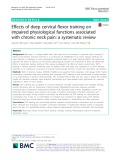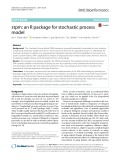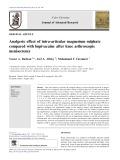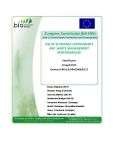
Physiological outcome measures
-
Noise levels in hospitals, especially in intensive care units (ICUs) are known to be high, potentially affecting not only the patients’ well-being but also their clinical outcomes. In an observational study, we made a long-term measurement of noise levels in an ICU, and investigated the influence of various factors on the noise level, including the acute physiology and chronic health evaluation II (APACHE II) score.
 9p
9p  viisaacnewton
viisaacnewton
 26-04-2022
26-04-2022
 13
13
 1
1
 Download
Download
-
There is limited data available on the use of CPET as a predictive tool for disease outcomes in the setting of IPF. We investigated the feasibility of undertaking CPET and the relationship between CPET and quality of life measurements in a well-defined population of mild and moderate IPF patients.
 10p
10p  vijichoo2711
vijichoo2711
 31-05-2021
31-05-2021
 10
10
 1
1
 Download
Download
-
The 6-minute walk test (6MWT) is used to measure exercise capacity and assess prognosis in interstitial lung disease (ILD). Although the 6MWT is usually considered to be a test of submaximal exercise capacity in ILD, the physiological load imposed by this test is not well described and 6MWT outcomes are poorly understood.
 8p
8p  vimontana2711
vimontana2711
 05-04-2021
05-04-2021
 11
11
 2
2
 Download
Download
-
Neck pain is a major health issue with high rates of recurrence. It presents with a variety of altered sensorimotor functions. Exercise is a cornerstone of rehabilitation and many training methods are used. Exercise is evaluated in most randomized controlled trials on its pain relieving effects.
 17p
17p  vivermont2711
vivermont2711
 28-01-2021
28-01-2021
 12
12
 1
1
 Download
Download
-
The Stochastic Process Model (SPM) represents a general framework for modeling the joint evolution of repeatedly measured variables and time-to-event outcomes observed in longitudinal studies, i.e., SPM relates the stochastic dynamics of variables (e.g., physiological or biological measures) with the probabilities of end points (e.g., death or system failure).
 12p
12p  vioklahoma2711
vioklahoma2711
 19-11-2020
19-11-2020
 8
8
 1
1
 Download
Download
-
This work aimed to evaluate the analgesic efficacy of intra-articular injection of magnesium sulphate (4%) compared with equivalent volume of bupivacaine (0.5%) after outpatient knee arthroscopic meniscectomy. Forty patients were randomly assigned to two groups. Group M (n = 20) received intra-articular magnesium sulphate 4%, group B (n = 20) received bupivacaine (0.5%). Analgesic effect was evaluated by analgesic duration, and by measuring pain intensity at 1, 2, 4, 6, 12, 24 h both at rest and on knee movement to 90.
 6p
6p  kethamoi1
kethamoi1
 17-11-2019
17-11-2019
 15
15
 0
0
 Download
Download
-
Assessment: Several differences in lung anatomy and physiology place infants at theoretically greater risk than older children for respiratory failure. Despite this, respiratory failure is rare in infancy. Close monitoring, using a combination of the parameters other than PEF (Chapter 4, Component 4: Figure 4.4-1), will permit a fairly accurate assessment. Breathlessness sufficiently severe to prevent feeding is an important symptom of impending respiratory failure. Oxygen saturation, which should be measured in infants by pulse oximetry, is normally greater than 95 percent.
 180p
180p  dacotaikhoan
dacotaikhoan
 26-04-2013
26-04-2013
 63
63
 4
4
 Download
Download
CHỦ ĐỀ BẠN MUỐN TÌM



















